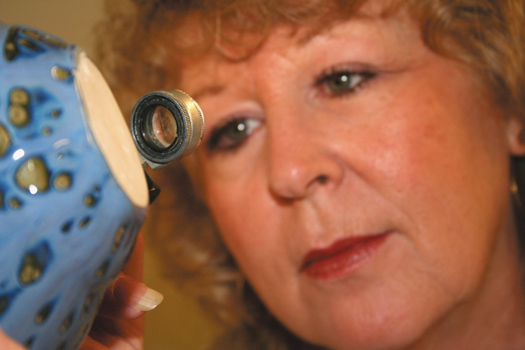 |
|
|
Kiln Pointers
|
|
|
A Potter’s Magnifying Glass |
CONTENTS A Potter’s Magnifying Glass Recent Q&As: firing glass pendants, stilts fired to cone 6, flash coming from Kiln Sitter A Vacation idea ------------ A POTTER’S MAGNIFYING GLASS By Lili Krakowski Many beginners are willing to spend big bucks on equipment but forget the essentials such as books and a magnifying glass. I have not worked on glaze without a magnifying glass since 1951. A strong magnifying glass or loupe is an essential tool when testing glazes. Magnification shows up crazes the naked eye can't see. It allows one to tell whether a glaze has a slight crawl or simply looks that way. One can tell tiny bubbles from pinholes and from material suspended in the glaze. And if the test-tile is broken, the interface between glaze and body--which many consider the most important aspect of glaze fit--is clearly visible. ---------- Lili Krakowski learned about magnifying glasses from Hobart Cowles. Lili has been potting since 1949 (a year after Paragon was founded), and graduated from the School for American Craftsmen in 1953. She is a studio potter making functional ware. In recent years she has been making sculptural pieces. She wrote "Basic Internet Glaze Course" (to be found on the Internet). -------- I recommend a printer's loupe as a potter’s magnifying glass. I used them in darkroom work before digital photography. The printer’s loupe is small and very powerful. The one I have used for many years is the No. 5410 Paragon 10X Triple Lens Folding Magnifier, which is available at www.americanprintingequipment.com for $66.00. (It is pure coincidence that it is named Paragon!) --Arnold -------------- RECENT Q&As Q. This is a follow-up question to your "Making A Simple Glass Fused Pendant" article. I've been told and have read many times that even to make a pendant like the one you pictured, I need to follow a slow ramp up schedule with a soak time, and a quick cool, followed by a very slow cool down. What did you mean when you wrote, "Firing and cooling time is as fast as your kiln will go”? Can I literally ramp up and cool down as fast as my kiln will go and still maintain the integrity of the glass? Will it be annealed properly? I am really hoping you say "Yes," as my total firing time including ramp up and cool down is 13 - 15 hours. A. Small glass projects such as the 3/4" x 1 1/2" pendant shown in the last Kiln Pointer can ordinarily be fired as fast as the kiln will go and without controlled cooling through the annealing range. For instance, Paragon's small QuikFire will reach 1000 degrees F in five minutes. That kiln fires the piece so quickly that you can hold the finished, completely cooled piece in your hand an hour after you begin the firing. The smaller and thinner the glass, the less annealing time needed. Long, slow firing schedules such as the one you are using are designed for thick glass such as large plates. This is especially true for pieces that have already been fused and are being fired a second time for slumping. Glass layers that are fused together require a slower firing than separate layers of the same size glass. Q. I recently fired cone 6 glazed ceramic pieces that had glaze on the bottom, so I sat them on stilts. Two of those came out completely fused into the stilts. Have you ever heard of that happening? A. Stilts are designed for low-fire ware in the 05 range. They can sometimes be used on very light cone 6 ware, but it is risky. If the ware is heavy, the stilts will embed into the clay. Q. My kiln has a Dawson Kiln Sitter. When the weight drops at the end of a firing, a faint flash appears. Is that normal? A. Yes. The flash is from the electrical contacts separating, which turns off the power to the elements. You will see the flash coming from behind the Kiln Sitter button. If you see a flash when you press in the Kiln Sitter button, it is because the kiln switches are turned on. Before pressing in the button, turn off all kiln switches. Turning on the switches before pressing the button will shorten the life of the Kiln Sitter contacts. --------- A VACATION IDEA A customer told me that he and his wife, who makes glass jewelry, visit the studios of local artists when they travel on vacation. Wherever they go, they feel immediate rapport with other artists. One year they visited Auvers, France, the town where Vincent Van Gogh lived out his last few months. A church that he painted is still standing; they enjoyed comparing it with his famous painting. As they gazed upward at the brick walls, tall windows, and the central tower, they felt that they were looking at the church through the eyes of Van Gogh himself. The church is near the cemetery where he is buried. Thank you, With best wishes, Arnold Howard Paragon Industries, L.P. – Better Designed Kilns 2011 South Town East Blvd. Mesquite, Texas 75149-1122 Voice: 972-288-7557 & 800-876-4328 / Fax: 972-222-0646 ahoward@paragonweb.com / www.paragonweb.com PRIVACY NOTICE: Under no circumstance do we share or sell your email address. Copyright 2008, by Paragon Industries, L.P. |
|
|

|
|
|
|
|
“Custom and standard Kilns and Industrial Furnaces for ceramics, pottery, heat treating, enameling, |
||||
